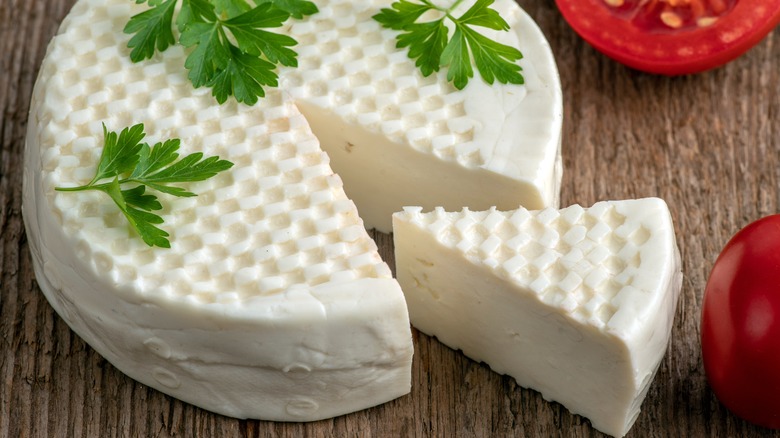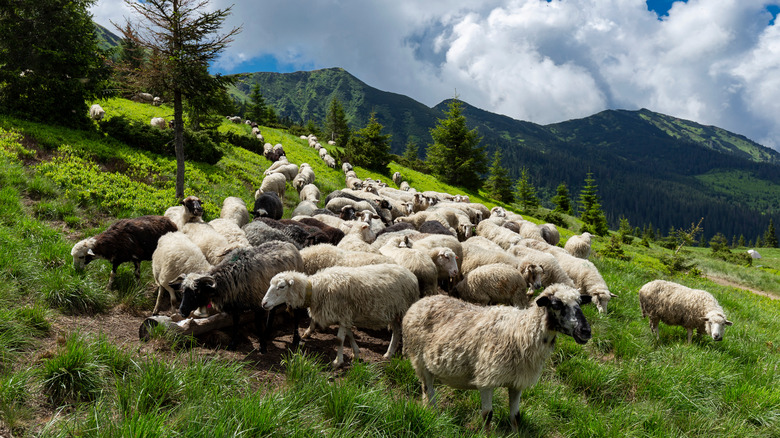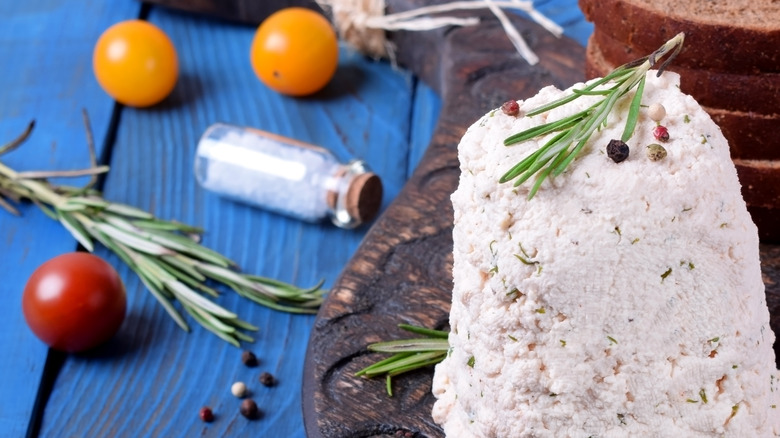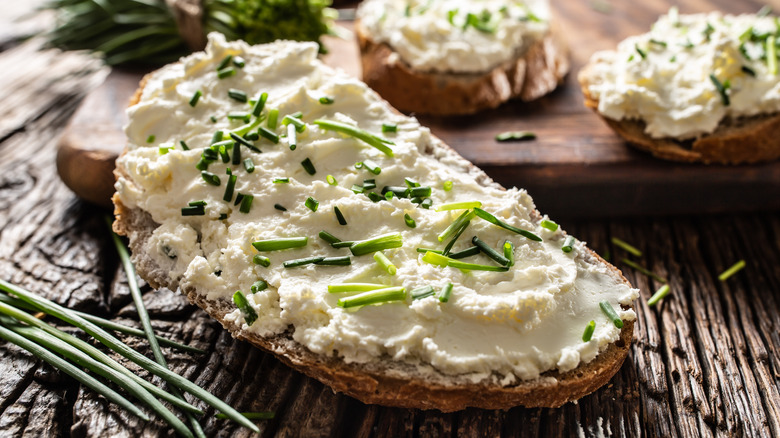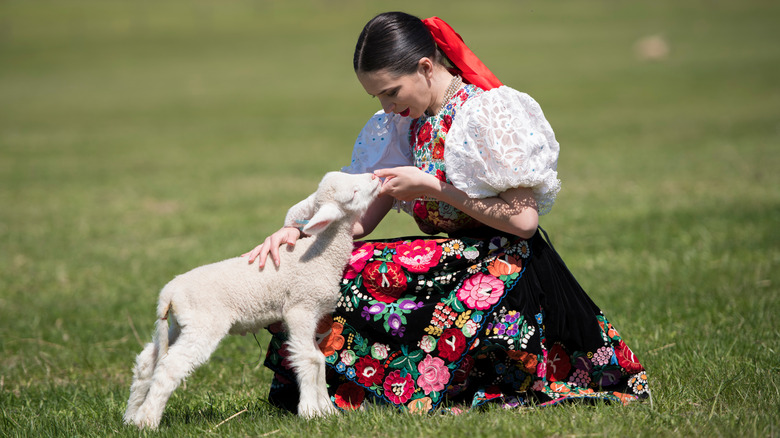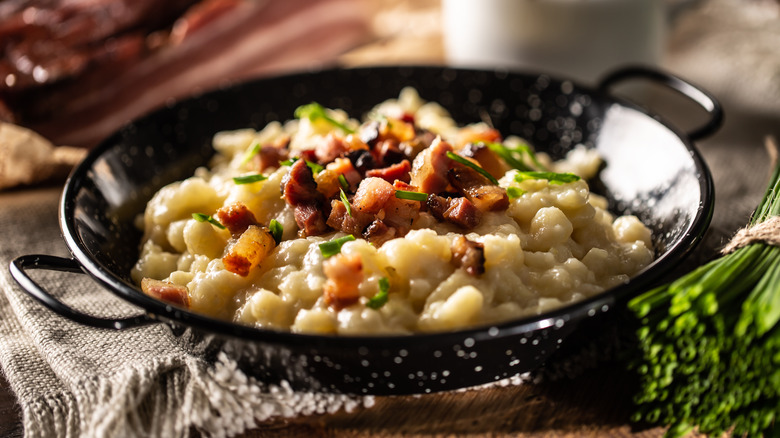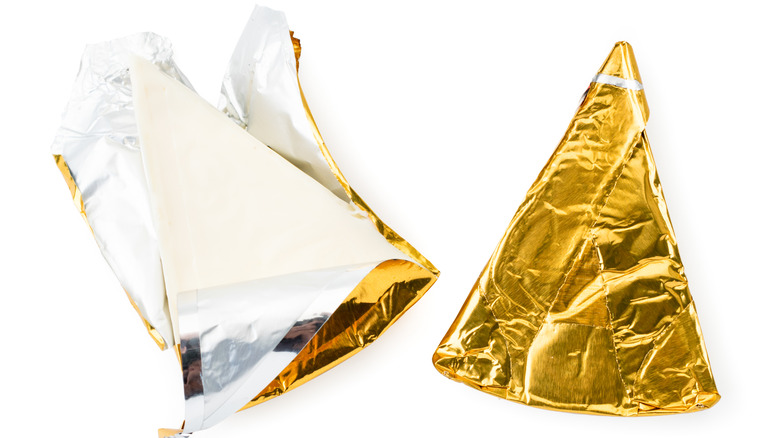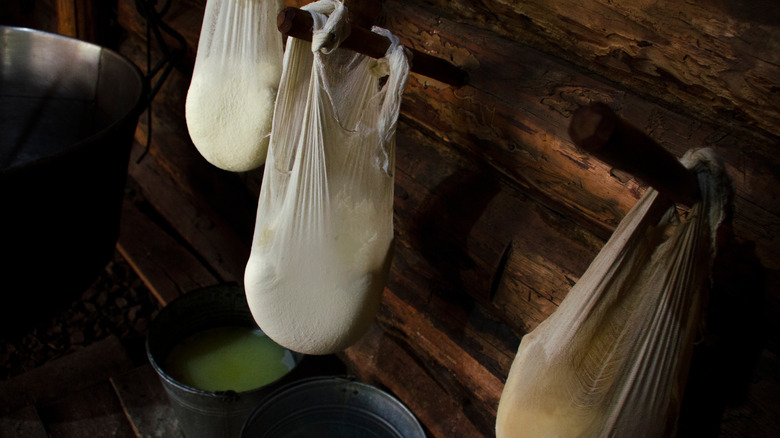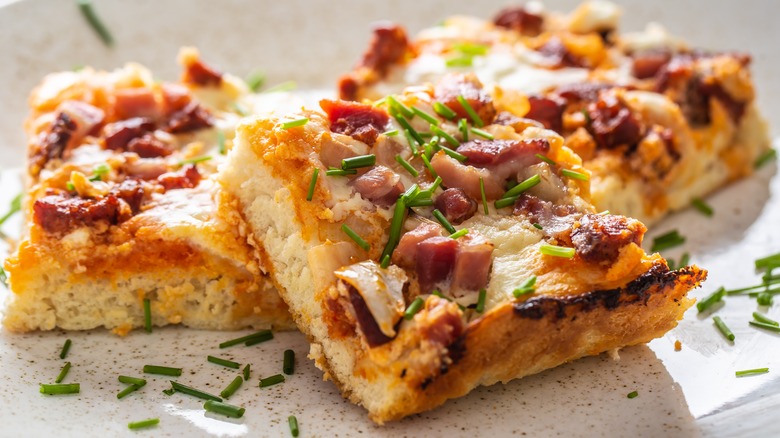Everything You Need To Know About Slovakian Bryndza Cheese
Bryndza, a white, creamy, and crumbly cheese from the mountains of Eastern Europe, has been a favorite for generations in Slovakia. In fact, the unique quality of the cheese is considered to be a protected product within the country (via Grand Magazine). Culinary cultural pride is what gives produce and recipes a sense of place, and cheese is no exception — whether it's feta from Greece or Parmesan from Italy. And Slovakians can certainly be proud of their country's bryndza cheese for its individual taste and timeless heritage.
Discover the mountain shepherd-filled history of bryndza and learn the difference between the cheese whether it is made in the summer or in the winter. Furthermore, find out how its purported health benefits have led it to be known as white gold. Get to know the taste, texture, and possibilities of a cheese that is so highly regarded that it's one of the main ingredients in Slovakia's national dish. Meanwhile, be tempted by other cheesy recipes that bring out the inimitable salty flavor of Slovakian bryndza. You may just find there's a new cheese to keep in your fridge.
Carpathian mountain shepherds created bryndza
Romanian shepherds settling in the Carpathian Mountains in Slovakia in the 14th century looked after hardy breeds of sheep that could survive the challenging environment and weather. The sheep were also essential to the settlers' survival by providing them with food (including cheese), milk, and warmth. In the 18th century, a creamery began to buy the sheep's milk cheese from these remote rural folk. They broke up the cheese, placed it in wooden barrels to preserve its freshness, and used butter as a sealant. This new product was soon distributed throughout the Austro-Hungarian Empire (via Slow Food Foundation for Biodiversity).
According to "Functional Properties of Traditional Food," Romanian shepherds began to introduce new breeds of sheep since herd numbers had declined in Slovakia. They also brought the knowledge of how to use rennet and process milk in order to make cheese, paving the way for the creation of bryndza, named after the Romanian word for cheese. Over time, however, the production of bryndza in this region changed as new ways of making it were developed, ultimately creating a uniquely Slovakian product.
Bryndza tastes salty and sour but is relatively low in salt
While some say Slovakian bryndza is similar in taste and texture to feta (per Delighted Cooking), the cheese proudly boasts its own unique flavor profile. Taste Atlas explains that the matured sheep milk content gives it a distinct sourness, as well as salty and spicy notes.
According to The Culture Trip, while the cheese can be quite salty, not much salt is actually added. Nowadays, the salt content deemed to be suitable is under 3%. Cheese.com describes that the saltiness (as well as the texture) of the cheese is ultimately dependent on how it's produced. For example, the salty taste and crumbliness are more pronounced when regular salt is added during the process. On the other hand, if a saline solution is used instead, the texture is creamier and far less grainy.
Great recipes for bringing out the cheese's saltiness include salty bryndza cake with dill and a pastry snack known as salty bryndza cheese tears made with butter, cheese, flour, and salt.
Slovakian bryndza is perfect for spreading
A Slovakian man named Ján Vagač was the first to manufacture bryndza commercially in 1787. His process yielded a cheese that was fattier than what the shepherds were making, and this made it easier to spread while simultaneously improving the shelf life (via "Functional Properties of Traditional Food"). In the 20th century, further developments in bryndza's production occurred, creating a texture that was even more spreadable.
At this time, there were around 80 producers making the cheese in Slovakia. Teodor Wallo was among them, and he enhanced the creaminess by introducing a saline solution method. This gave the Slovakian version of bryndza its own specific quality, distinct from versions in Romania and neighboring countries (via Slow Food Foundation). Crumbly styles of bryndza are still available, and milk or heavy cream is occasionally added to reduce the sharpness in flavor and soften the consistency, according to Delighted Cooking. Who doesn't love a creamy smear of cheese on bread?
Slovakian bryndza has EU protected status
In 2008, Slovakian bryndza was awarded protected status by the European Union, according to The Slovak Spectator. This means that the cheese is on the EU's Protected Geographical Indications register and can therefore only be produced within a certain mountainous region of Slovakia. Additionally, the cheese has to be made from either sheep's milk or a combination of sheep's and cow's milk.
Each regional version of bryndza has different standards to meet, according to Cheese.com. Slovakian bryndza must contain at least 50% sheep's milk, whereas the Polish variation made in the mountains in the Podhale region requires at least 60% sheep's milk. (Polish bryndza was given Protected Designation of Origin status in 2006.) There is also a Slovakian rendition that contains 100% sheep's milk; the Slovakian Sheep and Goat Breeders Association authenticates the pure bryndza cheese with a golden sheep logo (via Grand Magazine).
It is a main ingredient in Slovakia's national dish
The national dish of Slovakia – at least as far as most Slovakians are concerned — is bryndzové halušky. This Eastern European dumpling dish is pure comfort food on a plate and uses minimal ingredients, including bryndza of course. When cottage cheese made from cow's milk is used as an alternative, the dish's name becomes halušky s tvarohom.
The quality of bryndza shines splendidly against the soft, pillowy dumplings. Essentially, you make them from grated raw potatoes and flour (milk is optional), then boil them in salted water until they rise to the top. Rinse the dumplings, then mix them with bryndza and top it all off with fried bacon bits as garnish. Enjoy the dish the traditional way: with a cup of milk on the side (via Simple English News). The Spruce Eats notes that the dumplings are a great option to serve as a side or main. Meanwhile, there are plenty of recipe variations to try such as adding eggs or chives to the dumpling mix or adding grated cooked potatoes.
Bryndza has potential probiotic properties
A 2013 study published in BioMed Research International revealed the probiotic potential of bryndza. In the study, 125 lactobacilli bacteria were isolated from the Slovakian cheese. Researchers looked into the antimicrobial activity of these strains in relation to eight bacterial pathogens. The conclusion notes that Lactobacillus plantarum present in the cheese indicated positive antibacterial activity and resistance to acid, making it a potentially useful probiotic.
What this amounts to is that Slovakian bryndza cheese could be really good for your gut. Probiotics are found in many fermented foods such as kimchi, miso, and kefir, and they help train your stomach to fight off bad kinds of bacteria, per Harvard Medical School. Traditional bryndza from the mountains is even richer in probiotics, according to Real Deal Plus, since it is made using raw sheep's milk that has not been pasteurized and can pack in over a billion healthy bacteria per gram.
Bryndza is known as white gold
In addition to gut-friendly microorganisms, Slovakian bryndza is a rich source of several vitamins and minerals. Traditionally, the cheese has been considered to have various medicinal properties, making it worthy of its moniker in Slovakia: white gold. Grand Magazine notes that the cheese is high in protein and calcium, making it a healthy ingredient for increasing muscle development and improving maintenance. Meanwhile, Real Deal Plus adds a trio of vitamins to its roster of health accolades: vitamins A, B, and D.
Grand Magazine also touts bryndza as being anti-inflammatory, adding that it can have a positive impact on blood pressure and cholesterol. The Ministry of Agriculture and Rural Development of the Slovak Republic claims that local bryndza is beneficial in protecting against a host of ailments including allergies, asthma, eczema, multiple sclerosis, digestive issues, osteoporosis, Type 2 diabetes, and even cancer. It's no surprise that this cheese is enjoyed by so many people.
Bryndza made in summer is different than the winter product
During the summer months when sheep milk production is taking place, sheep lump cheese and salted water are used to make what is known as summer bryndza. Some of this cheese is salted after being crumbled and then stored in wooden barrels for use beyond the production season. Meanwhile, during the colder months, the cheese is mixed with cow's milk to create winter bryndza (via "Global Cheesemaking Technology").
In other words, winter bryndza is a blend of cow curd cheese and salted summer bryndza. The cheese that's produced in May is regarded as being of the best quality, as the sheep have already been grazing in the pastures for some time, consuming nutrient-rich grass (via Grand Magazine). The summer variety of bryndza created using milk from sheep that have been grazing in grassy flowery meadows is said to have a subtler flavor than the winter cheese (via Real Deal Plus).
Bryndza recipes are delicious
There's more to bryndza than the Slovakian national dish of cheesy potato and flour dumplings. While the cheese was traditionally eaten simply just with bread, it is now used to make a number of delicious recipes. From salty snacks to spreads, bryndza is an integral ingredient in Slovakian cuisine (via Real Deal Plus). For example, it can be used to make pirohy (ravioli-style dumplings filled with cheese), as well as a potato and bryndza soup called demikát (via Slow Food Foundation).
The Ministry of Agriculture and Rural Development of the Slovak Republic describes bryndza as a cheese that can be eaten at any mealtime and as an ingredient in pies, pizzas, or salads. One tasty way to use it is by making a quiche with an egg, bryndza, cream, and sour cream filling seasoned with onion, garlic, olive oil, and nutmeg (via Agrofarma).
There are so many recipes that highlight the unique flavor and texture of Slovakia's bryndza cheese. It is a taste of the history, culture, and agricultural heritage of Slovakia, inspiring visions of green pastures, soaring mountain vistas, and a culinary heritage that's connected to the land. For Slovakians, and perhaps for everyone, it's a taste of home.
